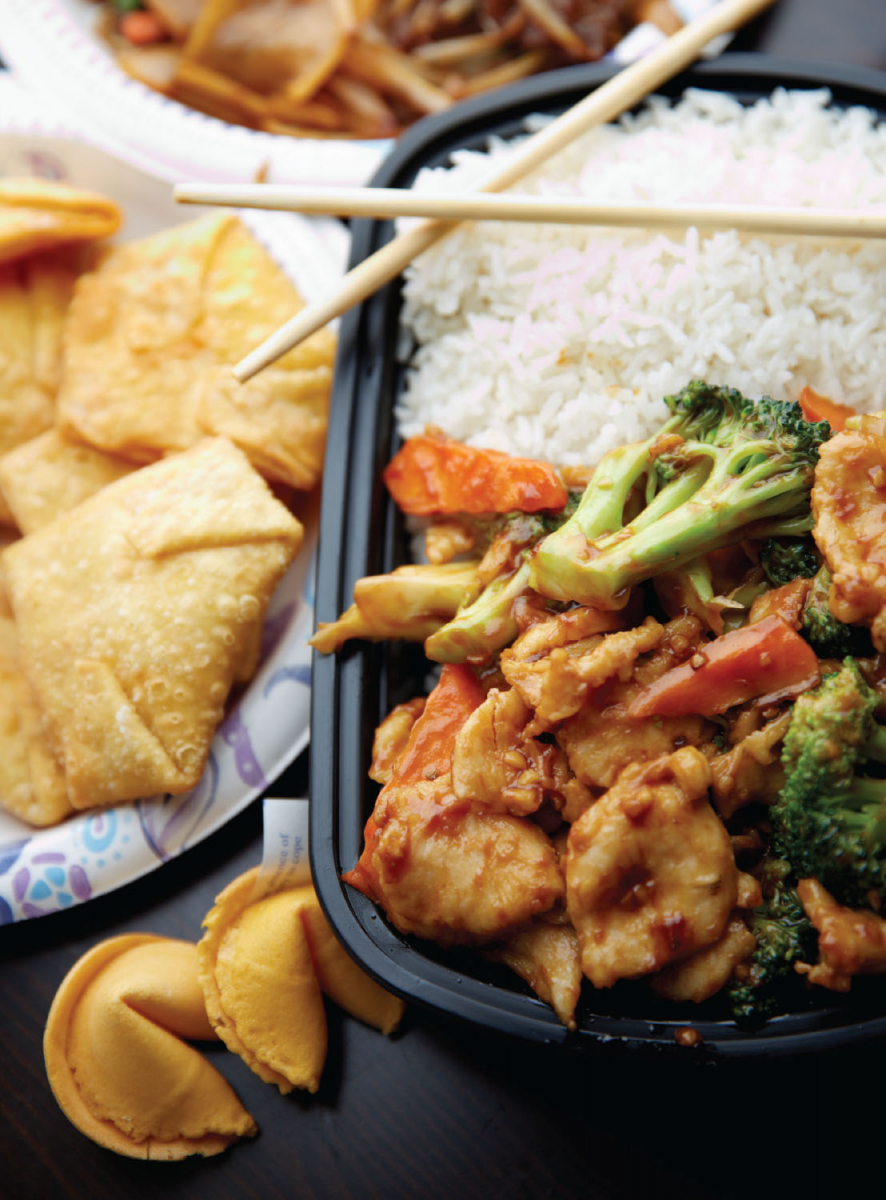
For lovers of Asian fare, there’s nothing better than some lightly crispy egg rolls stuffed with tangy cabbage, cooked in the authentic style, or crisp veggies stir-fried in a wok alongside tender nuggets of your preferred protein, all smothered in a salty sauce and draped atop jasmine rice or rice noodles.
For Jackie Chang and Wanyi Tong, that’s exactly what they set out to bring to their hometown of Woodbury—but simple and elevated, in the traditional style—when they opened Little Chopstix in 2015, in what was once “a big corn field,” Tong says. “Now the location couldn’t be better, with a Starbucks right next to us, and Noodles and Target … At the beginning, it was challenging [getting to know the restaurant ropes as just a husband-wife team], but as we’ve progressed, we’ve been able to figure out what the rush times will be, and when we need to hire more staff.” Currently there are nine employees in addition to Chang, who runs the back of the house, and Tong, who runs the front.
Both Chang and Tong are of Chinese descent. “Jackie has been cooking since he was 17, and I used to work for a food distribution company that specialized in Asian food supply, so it comes naturally to us to have a restaurant,” Tong says. “We like to do things we are good at, and this just comes natural to us.” It’s not just Chinese food they serve—that’s a broad category. Their style is traditional Cantonese, which uses intentional combinations of salt, sugar, soy sauce, rice vinegar, garlic, ginger and scallions, famous for chow mein and sticky rice that originated in the Guangdong Province of China. (Historically, most American Chinese restaurants serve Cantonese-inspired dishes.)
True to one of the main tenets of Cantonese dining, “simplicity—foods should taste like what they are”—Tong says dishes are made fresh to order. “One of the highlights of our restaurant is we do make everything to order, and we customize a lot of stuff. Fried rice is not premade; every order that comes in is made on the spot, and we’re pretty fast. We can fix everything within 10 minutes when there’s not long line.”

Core to their business success are return customers, and the Woodbury location pulls from Lake Elmo and Oakdale as well. Lunch crowds include Woodbury healthcare personnel and folks from 3M. Takeout makes up about 50 percent of the orders, Tong says, and Little Chopstix also offers delivery. They incorporate an online ordering system, which a lot of customers are starting to use, making wait times even shorter.
“We do what we’re good at, try to simplify our menus; we started at 110 items and have trimmed it down to what really works for us [and] what sells the best,” Chang says. “We started as a family business and didn’t want to complicate it with too many inventories. We want to make sure that whatever we do, we master it.”
Two of Tong’s recommended dishes are authentic Cantonese: the Singapore Mei Fun, a combination of shrimp, pork and chicken stir-fried with skinny rice noodles in a curry sauce, and beef chow fun (each $12.95). “If you are looking for something authentic, that’s where I’d [start]. Beef chow fun is my personal favorite,” Tong says, adding it’s a more authentic, non-breaded entrée that’s not as sweet as some American Chinese dishes. Tender organic beef flank is stir-fried with flat rice noodles. On the popular side of the menu, Mongolia beef ($11.95) and sesame chicken ($12) are the best-sellers, she says.
Tong says residents are still surprised by the customized care that goes into each meal. “Customers who are gluten-free or need to have no soy, we can do that,” she says, adding that another thing that surprises some is the fact they deliver out to a four-mile radius (for an extra $2 delivery fee and a minimum order of $20).
On the horizon for Little Chopstix? Because of the method of cooking, large-batch equity is a possibility, so the natural request from customers is for catering. “We’re not advertising it much, but we’ve been asked to do catering a lot, and we can offer basic foil trays of food, but we are not fully mature on that yet,” Tong says. “We get lots of requests for graduations, and we want to get a bit more professional on that side of it, perfect it. [We want to] spend more time and figure out the system: ‘How do I perfect that side of the business?’ Right now, we are focusing on the delivery and the daily things.” And those daily things are so delicious.
Little Chopstix Restaurant
580 Woodbury Drive, Suite 200
651-797-4133
Facebook: Little-Chopstix
Try It At Home
The original fast-and-ready, Chinese food in America has a wide-ranging and varied history. A far cry from the coastal Chinatowns of the 1800s, Midwestern Chinese is most certainly Americanized, but that doesn’t mean it can’t be cooked using authentic methods. Wanyi Tong, owner of Little Chopstix in Woodbury, says that “the wok, the temperature, the cooking needs to come together to make authentic Cantonese dishes.” Here’s two of her favorite recipes.
Beef Chow Fun
- 1 pack of fun noodles (available at most Asian groceries; pre-heat in microwave for 1 minute, cut into 1-inch strips, then separate them)
- 8 oz. flank steak, sliced
- 1 cup sliced onion
- ½ cup bean sprouts
- 5 oz. eggs, whisked
- 5 oz. soy sauce
- 2 oz. chopped or minced garlic
- 2 tsp. salt
- 1 tsp. chicken base
First, scramble the eggs in the usual fashion, and set aside. Stir fry only flank steak to medium, then set aside for later use. Put onion, garlic and bean sprouts in hot pan for 1 minute, stir them constantly, then add fun noodles into the pan. Keep stirring, making sure nothing sticks to the pan. Add scrambled eggs and flank steak, then keep stirring for 1 minute. Add soy sauce, making sure it is evenly distributed, then add salt and chicken base at the end. Keep stirring for another minute before removing from the pan. Serve immediately.
Singapore Mei Fun
- 70 g. rice noodle (boiled till softened, then let it sit until dry)
- 1 egg
- 30 g. each shrimp, chicken and roast pork
- 10 g. Napa cabbage
- 10 g. onion, sliced
- 6 g. scallion
- 1 tsp. salt
- 1 tsp. chicken base
- or sugar
- 1 tsp. curry powder
- Hot chili oil (optional)
- Salad oil
First, scramble the egg and remove it from the wok. Heat up the wok with salad oil, than add shrimp, chicken and roast pork and stir for one minute. Add onion and Napa cabbage and cook on high heat for one more minute, then add rice noodles. Mix in curry powder and stir until curry is evenly distributed. Finally, add salt and sugar/chicken base.
To finish, toss in scallions and the scrambled egg at the end for 10 seconds before removing the dish from the wok. Serve immediately.
Chinese Food Glossary
Sauces: Soy sauce, rice vinegar sesame oil and rice (or yellow) wine are needed for wok cooking and classic flavoring in almost every Chinese dish. There are, of course, variances depending on the recipe. Be sure to select Chinese soy sauce; note that there are both light and dark soys; use light soy sauce (or regular) unless specifically noted. Oyster sauce, fish sauce and hoisin (sweet bean) sauce are other common sauces.
Spices: The key seasonings in Cantonese cooking are salt, pepper and sugar; simple, right? Of course, there are specifics and varieties of each. Brown block sugar, for example, or white pepper and green or red Sichuan peppercorns are some of these examples. Five-spice powder, which is a combination of peppercorns, fennel, cloves, cinnamon and anise, is common in many dishes. Other flavors include ginger, cardamom, turmeric, cumin, curry powder and sesame seeds.
Greens: Common Asian leafy greens include bok choy, Chinese broccoli, choy sum, napa cabbage, water spinach, watercress, pea shoots and shepherd’s purse, though this list just scratches the surface.
Rice and noodles: Cantonese people’s choice is still the common long grain white rice, whether it’s served sticky, jasmine-style or fried. For noodles, there’s pan-fried chow mein (crispy skinny) to lo mein to the wider chow fun. Noodles are paired with sauces to allow a platform to enhance and hold the flavors of the dish.
Tofu: Available fresh, dried and even frozen, this protein substitute is popular in many Chinese dishes.









